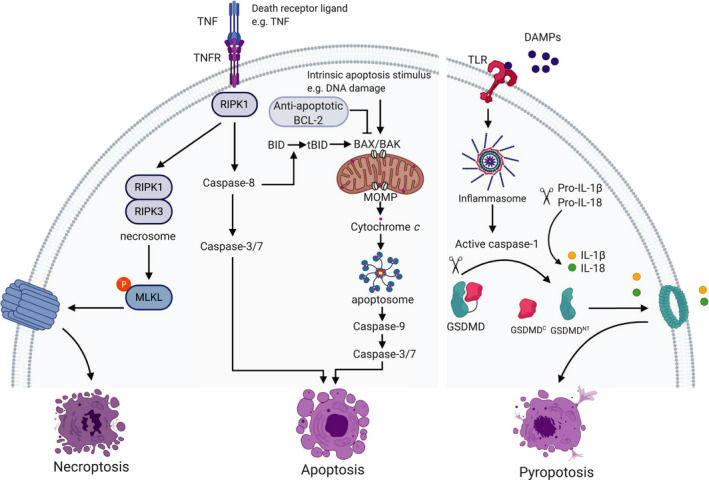Fig. 1.

Overview of necroptosis, apoptosis, and pyroptosis signaling pathways. Binding of death ligands such as tumor necrosis factor (TNF) to their cognate receptor (TNFR) leads to pleiotropic signaling including inflammation and cell survival, apoptosis, and necroptosis, determined by the key signaling molecule, the receptor‐interacting serine/threonine protein kinase 1 (RIPK1). Upon inhibition of caspase‐8, RIPK1 activates RIPK3 leading to the formation of the necrosome. The necrosome then phosphorylates and activates mixed‐lineage kinase‐like (MLKL) that causes rapid membrane permeabilization and necroptosis. Activation of caspase‐8 leads to activation of caspase‐3 and caspase‐7 and cell death (extrinsic apoptosis). The intrinsic apoptosis pathway is initiated by perturbation in the internal environment including DNA damage that causes mitochondrial outer membrane permeabilization (MOMP). MOMP is regulated by the interaction between pro‐apoptotic and anti‐apoptotic B‐cell lymphoma 2 (BCL‐2) family proteins. The pro‐apoptotic proteins BCL‐2 associated X (BAX) and BCL‐2 homologous antagonist killer (BAK) form pores at the mitochondrial outer membrane leading to the subsequent release of cytochrome c and the formation of the APAF‐1 apoptosome. The apoptosome activates caspase‐9, which subsequently activates caspase‐3 and caspase‐7 resulting in apoptosis. Caspase‐8 mediates the crosstalk between the intrinsic and extrinsic apoptosis pathways by cleaving the pro‐apoptotic BH3‐interacting domain death (BID) to truncated BID (tBID) that activates BAX and BAK. Damage‐associated molecular patterns (DAMPs) released from dying cells activate pattern recognition receptors such as Toll‐like receptors (TLR). This leads to the activation of canonical inflammasomes that activate caspase‐1. Active caspase‐1 cleaves gasdermin D (GSDMD) liberating an N‐terminal (GSDMDNT) pore‐forming fragment from the C‐terminal (GSDMDC) inhibitory fragment. GSDMDNT form pores leading to membrane permeabilization and pyroptosis. Active caspase‐1 also cleaves the pro‐inflammatory cytokines interleukin 1β (IL‐1β) and IL‐18 into their mature form that are released by GSDMD pores.
